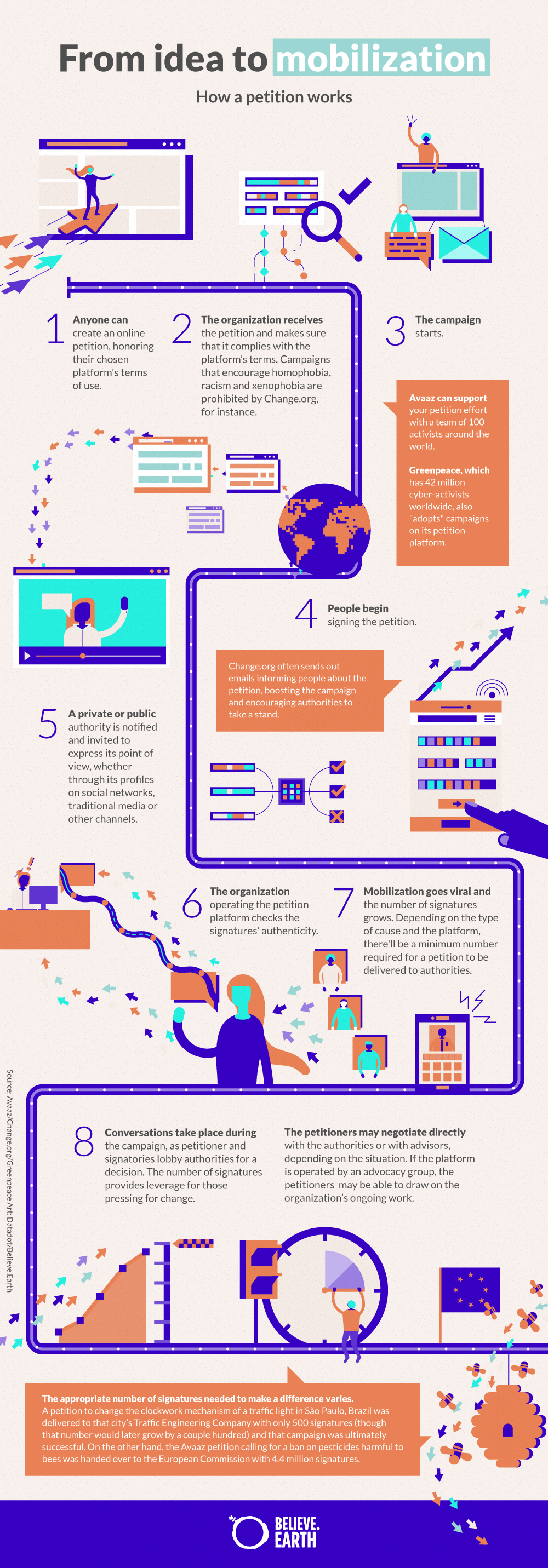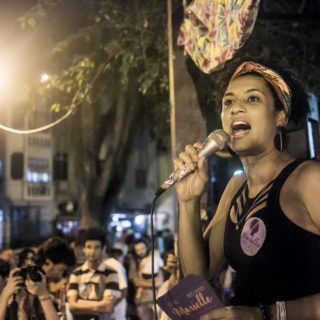The online petition has been used as a pressure tactic. Avaaz and Change.org are the most important platforms for such petitions and bring together more than 300 million users worldwide. But, are petitions effective? Yes, they are, if they engage people.
A recent campaign of great impact was the banning of neonicotinoids by the European Union. This class of pesticides has been responsible for reducing bee populations. On April 16, eleven days before the European Commission met to decide the issue, a team of activists from Avaaz delivered a petition with 4.4 million signatures to the representatives of the member countries, requesting that they ban the pesticides. (The number of signatures on that petition later reached more than 5 million.) On April 27, the Commission approved the ban on neonicotinoids, a measure that should go into effect by the end of the year.
In the United States, you can create petitions on the official White House website (a minimum of 100,000 signatures must be achieved within 30 days for the petitions to be delivered). In the United Kingdom, if petitions attract at least 10,000 signatures, Parliament must at least answer them. If the number of signatures reaches 100,000, Parliament will nearly always debate the issue (if it hasn’t already done so).
As long as they respect Change.org’s terms of use (the platform prohibits campaigns encouraging homophobia and racism, for example), any person can create a petition on any subject, the site’s campaign director, Rafael Sampaio, explained. The service selects especially important petitions created by its users and provides them with free consulting to increase their chances of success. Avaaz, for its part, sometimes creates its own petitions and sometimes “adopts” existing petitions.
Another success story was the petition on behalf of British-Iranian student Ghoncheh Ghavami. Although living in London, when visiting Iran in June 2014 she was arrested for attending a volleyball match (women in Iran have been banned from attending men-only volleyball matches since 2012). She was charged with “propaganda against the [Iranian] regime,” and held in solitary confinement. Her brother, Iman Ghavami, created a petition on Change.org, addressed to the governments of the United Kingdom and Iran, demanding Ghoncheh’s freedom.
In September of the same year, he delivered a petition with approximately 400,000 signatures to the representatives of the Iranian mission to the UN in New York. He appealed to the president of the country, Hassan Rohani, asking for his sister’s freedom. He also urged British petitioners to send messages through the Write to Them service, which will send emails to any UK politician. Iman got his answer and his sister was released in March of that year. “The petition played an important role in my sister’s case,” Iman told the British edition of HuffPost.

Crucial to the success of a petition platform is the site’s ability to check the authenticity of the signatures received (even when these number in the thousands or millions). Platforms use protocols and algorithms to ensure that there are no fraudulent signatures. Whenever a suspicious email address is identified, it is deleted from both the petition and the subscriber base. The credibility of the petitions depends on the effectiveness of this process.
The minimum number of signatures will depend on the campaign context. A petition can be addressed to companies or governments, or intended to solve a local, national or global issue. Greenpeace international campaign strategist Graziela Tanaka explains that for petitions involving global environmental problems, the minimum her organization will accept is hundreds of thousands of signatures. But, on issues of local interest, hundreds may be adequate. “It is important to keep in mind that causes vary in size and it is our mission to give voice to all of them. It empowers people,” says Change.org executive director Lucas Pretti.
Daniel Graf, a designer and a resident of São Paulo, Brazil, created a petition addressed to the city’s Traffic Engineering Company – CET), requesting an adjustment in a traffic light’s clockwork mechanism, which did not allow pedestrians enough time to cross a busy avenue. It took only 703 signatures to make this change.
Regardless of the cause size, bear in mind that the petition is unlikely to succeed without additional activism. “The petition is the tip of the iceberg and must be accompanied by other parallel action, such as the online and offline work of activists and volunteers,” explains Diego Casaes, coordinator of Avaaz Campaigns in Brazil. The work may involve cyber-activism, like tweets, as well as “real” protests. It can also entail behind-the-scenes advocacy work: follow-up with legislative aides on issues related to the petition, identifying allied politicians and participation in legislative hearings. “It is less visible work, but of enormous importance,” explains Greenpeace’s Tanaka.
Camila Asano, a coordinator at Conectas Direitos Humanos, a human rights group in Brazil, concurs. “The petition needs to be launched as a campaign,” she says. In 2016, her organization did just that, with a petition seeking the approval of a new immigration law, replacing the Foreigner’s Statute, which had been in effect since the military dictatorship. With 9,000 signatures, the petition was handed over to Bruna Furlan, the chair of the Special Committee, who was analyzing new draft legislation for the Chamber of Deputies. In addition to circulating the petition, Conectas Direitos Humanos lobbied senators and members of Congress, engaged the Organization of American States (OAS), and held public events.
The draft was approved and the new law went into effect last November with advances such as a formal condemnation of xenophobia and a ban on using detention in the immigration process. Asano explains that although the number of signatures was a little low for a national campaign, the petition nonetheless played an important role in discussion of the new legislation.
Published on 08/22/2018



